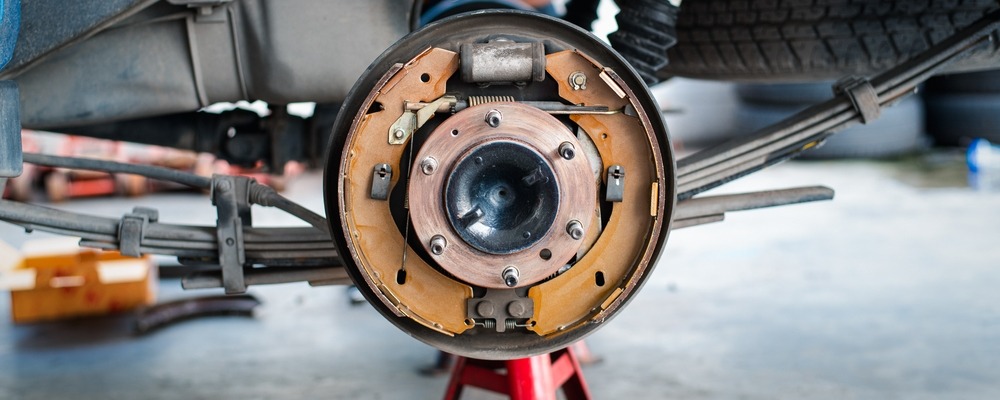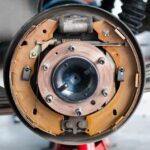- March 30, 2022
- Posted by: Wentworth
- Category: Brakes

 Let’s explore the specifics of Drum Brakes in Part 2 of our Automotive Brakes Blog Series. We will review how drum brakes work and which vehicles have drum brakes. We’ll look at the components found in the drum braking system, including the brake drum, wheel cylinder, and brake shoes. If you have problems with your drum brakes, continue reading to find out how to diagnose common drum brake issues. And finally, we will discuss routine drum brakes repair, maintenance, and brake fluid intervals.
Let’s explore the specifics of Drum Brakes in Part 2 of our Automotive Brakes Blog Series. We will review how drum brakes work and which vehicles have drum brakes. We’ll look at the components found in the drum braking system, including the brake drum, wheel cylinder, and brake shoes. If you have problems with your drum brakes, continue reading to find out how to diagnose common drum brake issues. And finally, we will discuss routine drum brakes repair, maintenance, and brake fluid intervals.
What are Drum Brakes?
The foundation of the modern braking system in automobiles started with Drum Brakes, designed in 1899. Typically, drum brakes were the braking system used in most antique, vintage, and classic cars. Drum brakes are often found on the rear wheels of modern, basic-model automobiles because they are cost-efficient and lightweight. Additionally, some modern vehicles come equipped with a braking system that uses disk brakes in conjunction with drum brakes.
How Do Drum Brakes Work?
Drum brakes are activated once the driver presses the brake pedal. This action causes the piston inside the master cylinder to pressurize the hydraulic fluid in the brake lines. Then the wheel cylinder is pressurized and pushes the brake shoes into the drum, causing friction. This friction reduces tire rotation, causing the vehicle to slow down. More friction is generated when the driver increases the force on the brake pedal. The overall movement of the brake shoes is slight, and there are return springs that pull the brake shoes away from the drum once the driver releases the brake pedal.
Drum Braking System Components
The components found in the drum braking system consist of the following:
- Automatic adjuster: Maintains a consistent distance between the brake shoes and the drum, even as the lining wears down.
- Brake drum: Attached to the wheel hub and rotates with the wheel. Usually made of cast iron and is resistant to high temperatures & wear. The brake shoes engage the brake drum, creating friction that slows and stops the vehicle.
- Backing plate: Fastened to the axle sleeve and provides a solid base for other components in the drum brake.
- Brake shoe: Each drum brake includes two shoes. The primary shoe is towards the front of the vehicle, and the secondary shoe is towards the rear. They are secured to the backing plate but can slide when pressure from the wheel cylinder is applied. They are lined with organic or metallic compounds and wear down with use.
- Return springs: Returns the brake shoes to a neutral position, away from the brake drum, when the driver releases the brake pedal.
- Wheel cylinder: There is one cylinder per wheel, each containing two pistons – one at each end of the cylinder. The wheel cylinder applies pressure to the pistons, pressing the brake shoes onto the drum, creating friction. This friction eventually slows and stops the vehicle.
Emergency Brake
All vehicles come equipped with an emergency (or parking) brake as a safety feature. There may be a small drum brake within the wheel hub assembly, even on automobiles with disc brakes on all four wheels. A lever fastened to a cable forces the brake shoes apart when the emergency brake is engaged. The emergency brake directly contacts the drum and avoids both the wheel cylinder and brake hydraulics. The emergency drum brake enables the automobile to slow and stop, even if the disc braking system has failed.
Diagnose Common Drum Brakes Issues
Brakes may be the most critical safety feature in your vehicle. Be aware of any changes to your vehicle’s braking behavior that indicate that your drum brakes need service, repairs, or replacements.
- Noisy Brakes: Shoe lining wears down with use. Have you noticed excessive or unusual noises when you engage the brakes? In that case, it could indicate that the lining is getting low. Your service technician can inspect and replace the brake shoes easily.
- Shaking Brake Pedal: If the brake pedal shakes or vibrates when you depress it, your brake drums may be warped. Warping can occur through overuse or overheating. Brake drums should be perfectly round to operate correctly. Your service technician can inspect and replace the brake drum to restore effective braking.
- Spongy Brake Pedal: The brake pedal should feel firm when you apply pressure to it. Does your brake pedal feel spongy or lower than normal? Then, there may be a leak in the system or contaminated brake fluid. Unfortunately, air or water in the brake fluid reduces its efficiency and can lead to brake failure. Your service technician can inspect and replace the brake fluid when necessary.
- Sticking Brake: The return springs may be broken or worn. A seized automatic adjuster can also cause the brake pads to drag against the drum. In addition, corrosion, debris, and excessive road grime may prevent any components from operating correctly. Your service technician can inspect and repair any of these issues.
Drum Brake Repair & Maintenance in San Diego
Drum brake maintenance & repairs are relatively straightforward. The brake drum and brake shoes should be the only parts that need replacing within a drum brake system. The shoe lining eventually wears down with use. Install new shoes every 35,000-miles, depending on your vehicle make/model and driving habits. Brake drums can last 100,000-miles or more.
When it is time for replacements, replace them in pairs. Fortunately, the automatic adjuster, return springs, and wheel cylinder should last the lifetime of your vehicle. Of course, road debris or car crashes may cause mechanical issues with your drum braking system. Remember to check your vehicle’s brake fluid every 24,000 to 36,000-miles and schedule a brake service if you suspect a brake fluid leak.
Schedule Drum Brake Repairs & Maintenance
Correctly maintaining and repairing your drum brakes is our #1 priority at Wentworth Automotive. All our technicians are ASE Certified & Master Mechanics. We use nothing but high-quality auto parts in all our brake repairs and drum replacements. Your safety depends on the mechanical condition of your vehicle. We work hard to provide quality brake service at an affordable price, backed by our automotive warranty.
For a brake repair, trust Wentworth Automotive with your car, truck, or van. To learn more about our brake repair services, don’t hesitate to contact us by phone at (858) 541-1044 or visit our website to make a reservation today.

